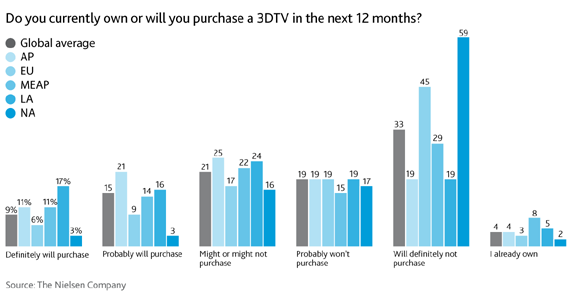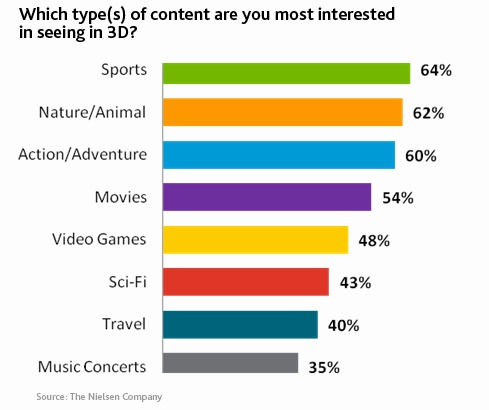About 13% of us already own a 3DTV or will definitely purchase one in the next year, and another 15% will probably do so too, according to a survey by The Nielsen Company.
 Not surprisingly, interest and intent to purchase is highest amongst consumers ages 21-34, and strongest in Asia Pacific, Latin America and MEAP (Middle East, Africa, Pakistan) markets. Consumer interest in Europe and the U.S. still trails the rest of the world.
Not surprisingly, interest and intent to purchase is highest amongst consumers ages 21-34, and strongest in Asia Pacific, Latin America and MEAP (Middle East, Africa, Pakistan) markets. Consumer interest in Europe and the U.S. still trails the rest of the world.
The survey of about 27,000 online consumers was conducted in September across 53 countries.
In a separate study conducted by Nielsen, in collaboration with the Cable & Telecommunications Association for Marketers (CTAM) and CBS Vision, six in ten participants said 3DTV content was better than their current 2DTV viewing, and 48% found it more engaging. About 57% said it made them feel like they were part of the action, and 48% felt closer to the characters.
 That study exposed 12 groups and families to 30 minutes of 3DTV content in a traditional living room space in Sony’s 3D Experience Media Lab in MGM TVCity (Las Vegas). An additional 425 participants from around the country were also exposed to the same content in a more formal theater-style lab environment. The content included clips from a range of genres – nature, sports, comedy, a music concert, movies, and video games.
That study exposed 12 groups and families to 30 minutes of 3DTV content in a traditional living room space in Sony’s 3D Experience Media Lab in MGM TVCity (Las Vegas). An additional 425 participants from around the country were also exposed to the same content in a more formal theater-style lab environment. The content included clips from a range of genres – nature, sports, comedy, a music concert, movies, and video games.
So, how does all of this translate into consumer purchasing, the adoption rate of 3DTVs?
“Our research shows that, despite positive perceptions towards 3DTV programming, consumers are still hesitant to invest in 3DTV sets – opting to take a ‘wait and see’ approach,” said Frank Stagliano, EVP/GM of TV Primary Research for Nielsen. “Recent technology battles between plasma and LCD or blu-ray and HD DVDs have trained consumers to wait until widespread adoption is more likely. This drives down cost, making technology more affordable.”
Stagliano said some consumers are also deterred by the usability of the set and required glasses, fearing that 3D technology may inhibit TV as a relaxing medium. An all-3D network launching in early 2011 (the joint venture of Sony, Discovery, and IMAX) may make the “wow” factor more evident, and draw in more consumers.
David Poltrack, Chief Research Officer of CBS Corporation and President of CBS Vision, said he is confident 3DTV is “just going to be a part of television” like cable and high definition. “No one has taken the really powerful TV dramas and made them with the eye toward 3D,” said Poltrack. “I think once that happens, you’re going to see regular television programming capturing [and] being enhanced by 3D, and people are going to watch special episodes of their favorite programs in 3D.”

sounds exciting!